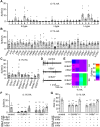Molecular Basis of Hexanoic Acid Taste in Drosophila melanogaster
- PMID: 37202372
- PMCID: PMC10336273
- DOI: 10.14348/molcells.2023.0035
Molecular Basis of Hexanoic Acid Taste in Drosophila melanogaster
Abstract
Animals generally prefer nutrients and avoid toxic and harmful chemicals. Recent behavioral and physiological studies have identified that sweet-sensing gustatory receptor neurons (GRNs) in Drosophila melanogaster mediate appetitive behaviors toward fatty acids. Sweet-sensing GRN activation requires the function of the ionotropic receptors IR25a, IR56d, and IR76b, as well as the gustatory receptor GR64e. However, we reveal that hexanoic acid (HA) is toxic rather than nutritious to D. melanogaster. HA is one of the major components of the fruit Morinda citrifolia (noni). Thus, we analyzed the gustatory responses to one of major noni fatty acids, HA, via electrophysiology and proboscis extension response (PER) assay. Electrophysiological tests show this is reminiscent of arginine-mediated neuronal responses. Here, we determined that a low concentration of HA induced attraction, which was mediated by sweet-sensing GRNs, and a high concentration of HA induced aversion, which was mediated by bitter-sensing GRNs. We also demonstrated that a low concentration of HA elicits attraction mainly mediated by GR64d and IR56d expressed by sweet-sensing GRNs, but a high concentration of HA activates three gustatory receptors (GR32a, GR33a, and GR66a) expressed by bitter-sensing GRNs. The mechanism of sensing HA is biphasic in a dose dependent manner. Furthermore, HA inhibit sugar-mediated activation like other bitter compounds. Taken together, we discovered a binary HA-sensing mechanism that may be evolutionarily meaningful in the foraging niche of insects.
Keywords: attraction; aversion; gustatory receptor; hexanoic acid; ionotropic receptor; noni.
Conflict of interest statement
The authors have no potential conflicts of interest to disclose.
Figures





Similar articles
-
Molecular basis of fatty acid taste in Drosophila.Elife. 2017 Dec 12;6:e30115. doi: 10.7554/eLife.30115. Elife. 2017. PMID: 29231818 Free PMC article.
-
Molecular and neuronal mechanisms for amino acid taste perception in the Drosophila labellum.Curr Biol. 2022 Mar 28;32(6):1376-1386.e4. doi: 10.1016/j.cub.2022.01.060. Epub 2022 Feb 16. Curr Biol. 2022. PMID: 35176225
-
Ionotropic Receptors Mediate Drosophila Oviposition Preference through Sour Gustatory Receptor Neurons.Curr Biol. 2017 Sep 25;27(18):2741-2750.e4. doi: 10.1016/j.cub.2017.08.003. Epub 2017 Sep 7. Curr Biol. 2017. PMID: 28889974 Free PMC article.
-
Gustatory perception and behavior in Drosophila melanogaster.Curr Biol. 2005 Sep 6;15(17):R673-84. doi: 10.1016/j.cub.2005.08.021. Curr Biol. 2005. PMID: 16139201 Review.
-
Molecular sensors in the taste system of Drosophila.Genes Genomics. 2023 Jun;45(6):693-707. doi: 10.1007/s13258-023-01370-0. Epub 2023 Feb 24. Genes Genomics. 2023. PMID: 36828965 Review.
Cited by
-
Acid and Alkali Taste Sensation.Metabolites. 2023 Nov 4;13(11):1131. doi: 10.3390/metabo13111131. Metabolites. 2023. PMID: 37999227 Free PMC article. Review.
-
Harnessing Insect Chemosensory and Mechanosensory Receptors Involved in Feeding for Precision Pest Management.Life (Basel). 2025 Jan 16;15(1):110. doi: 10.3390/life15010110. Life (Basel). 2025. PMID: 39860050 Free PMC article. Review.
-
Tastant-receptor interactions: insights from the fruit fly.Front Nutr. 2024 Apr 11;11:1394697. doi: 10.3389/fnut.2024.1394697. eCollection 2024. Front Nutr. 2024. PMID: 38665300 Free PMC article. Review.
-
Cholesterol taste avoidance in Drosophila melanogaster.Elife. 2025 Apr 17;14:RP106256. doi: 10.7554/eLife.106256. Elife. 2025. PMID: 40244888 Free PMC article.
-
Evolution of fatty acid taste in drosophilids.Cell Rep. 2023 Oct 31;42(10):113297. doi: 10.1016/j.celrep.2023.113297. Cell Rep. 2023. PMID: 37864792 Free PMC article.
References
MeSH terms
Substances
LinkOut - more resources
Full Text Sources
Molecular Biology Databases
Miscellaneous

